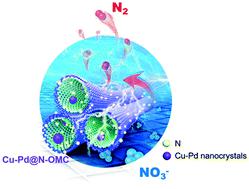当前位置:
X-MOL 学术
›
Environ. Sci.: Nano
›
论文详情
Our official English website, www.x-mol.net, welcomes your
feedback! (Note: you will need to create a separate account there.)
Nanodenitrification with bimetallic nanoparticles confined in N-doped mesoporous carbon
Environmental Science: Nano ( IF 5.8 ) Pub Date : 2020-03-17 , DOI: 10.1039/d0en00087f Jing Wang 1, 2, 3, 4, 5 , Wei Teng 1, 2, 3, 4, 5 , Lan Ling 1, 2, 3, 4, 5 , Jianwei Fan 1, 2, 3, 4, 5 , Wei-xian Zhang 1, 2, 3, 4, 5 , Zilong Deng 1, 2, 3, 4, 5
Environmental Science: Nano ( IF 5.8 ) Pub Date : 2020-03-17 , DOI: 10.1039/d0en00087f Jing Wang 1, 2, 3, 4, 5 , Wei Teng 1, 2, 3, 4, 5 , Lan Ling 1, 2, 3, 4, 5 , Jianwei Fan 1, 2, 3, 4, 5 , Wei-xian Zhang 1, 2, 3, 4, 5 , Zilong Deng 1, 2, 3, 4, 5
Affiliation

|
Nitrate and phosphorous contamination owing to increasing fossil fuel consumption and the use of modern fertilizers is the leading cause of the eutrophication and deterioration of water quality worldwide. Herein, we introduced an N-doped ordered mesoporous carbon-based skeleton with Cu–Pd nanocrystals (Cu–Pd@N-OMC) for the electrocatalytic reduction of NO3− to dinitrogen (N2). Laboratory experiments demonstrated high NO3− removal (91%) and N2 selectivity (97%) for eutrophic water treatment. The nanocatalyst also remained highly active over 15 experimental cycles. Metal–organic frameworks (MOFs) induced dispersion and the embedment of small Cu–Pd nanocrystals (4–9 nm) in the carbon mesochannels. Moreover, the metal loading was as low as 5 wt% with the Cu/Pd ratio at 4/1. The results suggested that the electrocatalytic reactivity could be fine-tuned by the size and crystallinity of the Cu–Pd nanoparticles through controlling the pyrolysis temperature. The high-density Cu–Pd nanocrystals promoted rapid hydrogen adsorption to cleave the N–O bond for high N2 selectivity. The incorporation of MOFs and OMC improved the dispersion and stabilization of metallic nanoparticles for prolonged electrocatalytic activity and durability.
中文翻译:

限制在N掺杂介孔碳中的双金属纳米粒子进行纳米脱氮
由于化石燃料消耗的增加和现代肥料的使用而导致的硝酸盐和磷污染是全球富营养化和水质恶化的主要原因。在此,我们引入了一个n掺杂的排序,铜-钯纳米晶体(铜-钯@ N-OMC)对NO的电催化还原中孔碳基骨架3 -到二氮(N 2)。实验室的实验证实高的NO 3 -去除(91%)和N 2富营养化水处理的选择性(97%)。在15个实验周期中,纳米催化剂还保持了高活性。金属有机框架(MOFs)在碳介孔中引起了分散和小的Cu-Pd纳米晶体(4-9 nm)的嵌入。而且,金属负载低至5wt%,Cu / Pd比率为4/1。结果表明,通过控制热解温度,可以通过Cu-Pd纳米粒子的大小和结晶度来微调电催化反应性。高密度的Cu-Pd纳米晶体促进了快速的氢吸附,从而裂解了N-O键,从而实现了较高的N 2选择性。MOF和OMC的结合改善了金属纳米颗粒的分散性和稳定性,从而延长了电催化活性和耐久性。
更新日期:2020-03-17
中文翻译:

限制在N掺杂介孔碳中的双金属纳米粒子进行纳米脱氮
由于化石燃料消耗的增加和现代肥料的使用而导致的硝酸盐和磷污染是全球富营养化和水质恶化的主要原因。在此,我们引入了一个n掺杂的排序,铜-钯纳米晶体(铜-钯@ N-OMC)对NO的电催化还原中孔碳基骨架3 -到二氮(N 2)。实验室的实验证实高的NO 3 -去除(91%)和N 2富营养化水处理的选择性(97%)。在15个实验周期中,纳米催化剂还保持了高活性。金属有机框架(MOFs)在碳介孔中引起了分散和小的Cu-Pd纳米晶体(4-9 nm)的嵌入。而且,金属负载低至5wt%,Cu / Pd比率为4/1。结果表明,通过控制热解温度,可以通过Cu-Pd纳米粒子的大小和结晶度来微调电催化反应性。高密度的Cu-Pd纳米晶体促进了快速的氢吸附,从而裂解了N-O键,从而实现了较高的N 2选择性。MOF和OMC的结合改善了金属纳米颗粒的分散性和稳定性,从而延长了电催化活性和耐久性。











































 京公网安备 11010802027423号
京公网安备 11010802027423号